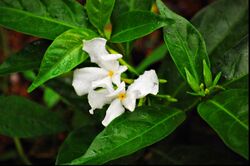Chemistry:Conolidine

| |
| Names | |
|---|---|
| Systematic IUPAC name
(4E,5S)-4-Ethylidene-1,4,5,7-tetrahydro-2,5-ethanoazocino[4,3-b]inden-6(3H)-one | |
| Identifiers | |
3D model (JSmol)
|
|
| ChemSpider | |
PubChem CID
|
|
| UNII | |
| |
| |
| Properties | |
| C17H18N2O | |
| Molar mass | 266.344 g·mol−1 |
Except where otherwise noted, data are given for materials in their standard state (at 25 °C [77 °F], 100 kPa). | |
| Infobox references | |
Conolidine is an indole alkaloid. Preliminary reports suggest that it could provide analgesic effects with few of the detrimental side-effects associated with opioids such as morphine, though at present it has only been evaluated in mouse models.
Conolidine was first isolated in 2004 from the bark of the Tabernaemontana divaricata (crepe jasmine) shrub which is used in traditional Chinese medicine.[1]
The first asymmetric total synthesis of conolidine was developed by Micalizio and coworkers in 2011.[2] This synthetic route allows access to either enantiomer (mirror image) of conolidine via an early enzymatic resolution. Notably, evaluation of the synthetic material resulted in the discovery that both enantiomers of the synthetic compound show analgesic effects.[3]
Syntheses
The Micalizio route (2011) achieved the end product in 9 steps from a commercially available acetyl-pyridine. Notable reactions include a [2,3]-Still-Wittig rearrangement and a conformationally-controlled intramolecular Mannich cyclization.
The Weinreb group (2014) used a conjugative addition of an indole precursor to an oxime-substituted nitrosoalkene to generate the tetracyclic skeleton of conolidine in 4 steps.[4]
Takayama and colleagues (2016) synthesized conolidine and apparicine through a gold(I)-catalyzed exo-dig synthesis of a racemic piperidinyl aldehyde.[5]
Ohno and Fujii (2016) accessed the tricyclic pre-Mannich intermediate through a chiral gold(I) catalyzed cascade cyclization.[6]
In 2019, a six step synthesis was developed using Gold-catalyzed cyclization reaction and Pictet-Spengler reaction having 19% overall yield.[7]
Pharmacology
In 2011, the Bohn lab noted antinociception against both chemically induced and inflammation-derived pain, and experiments indicated lack of opioid receptor inhibition, but were unable to define a particular target. A 2019 study by a cross-site Australian and U.S. group discovered through cultured neuronal networks that conolidine may inhibit the Ca v2.2 channel, a mechanism seen in molecules like conotoxin. The group was unable to rule out partial polypharmacology against other targets.[8]
It has been discovered to bind to novel opioid receptor ACKR3/CXCR7. By binding to that receptor, the endogenous opioid peptides (such as endorphins and enkephalins) cannot be trapped thus increasing availability of those peptides to their target sites.[9]
Derivatives
DS54360155, a novel compound with a unique and original bicyclic skeleton, is more a potent analgesic than conolidine in mice.[10] DS39201083[11] and DS34942424[12] are other similar derivatives. They all lack mu-opioid activity. The researchers who found conolidine binding site ACKR3/CKCR7 also developed a synthetic analogue of it called RTI-5152-12. It displays an even greater activity on that receptor.[9]
See also
References
- ↑ Kam, T.-S.; Pang, H. S.; Choo, Y. M.; Komiyama, K. (Apr 2004). "Biologically Active Ibogan and Vallesamine Derivatives from Tabernaemontana divaricata". Chemistry & Biodiversity 1 (4): 646–656. doi:10.1002/cbdv.200490056. PMID 17191876.
- ↑ Tarselli, M. A.; Raehal, K. M.; Brasher, A. K.; Groer, C.; Cameron, M. D.; Bohn, L. M.; Micalizio, G. C. (2011). "Synthesis of Conolidine, a Potent Non-Opioid Analgesic for Tonic and Persistent Pain". Nature Chemistry 3 (6): 449–453. doi:10.1038/nchem.1050. PMID 21602859. Bibcode: 2011NatCh...3..449T.
- ↑ Ball, P. (May 2011). "Compound Offers Pain Relief Without the Complications". Nature. doi:10.1038/news.2011.313. http://www.nature.com/news/2011/110523/full/news.2011.313.html.
- ↑ Chauhan, P.S.; Weinreb, S.M. (2014). "Convergent Approach to the Tetracyclic Core of the Apparicine Class of Indole Alkaloids via a Key Intermolecular Nitrosoalkene Conjugate Addition". Journal of Organic Chemistry 79 (13): 6389–6393. doi:10.1021/jo501067u. PMID 24927230.
- ↑ Takanashi, N.; Suzuki, K.; Kitajima, M.; Takayama, H. (2016). "Total Synthesis of Conolidine and Apparicine". Tetrahedron Letters 57 (3): 375–378. doi:10.1016/j.tetlet.2015.12.029.
- ↑ Noae, S.; Yoshida, Y.; Oishi, S.; Fujii, N.; Ohno, H. (2016). "Total Synthesis of (+)-Conolidine by the Gold(I)-Catalyzed Cascade Cyclization of a Conjugated Enyne". Journal of Organic Chemistry 81 (13): 5690–5698. doi:10.1021/acs.joc.6b00720. PMID 27276227. https://repository.kulib.kyoto-u.ac.jp/dspace/bitstream/2433/241631/1/acs.joc.6b00720.pdf.
- ↑ "Six-Step Total Synthesis of (±)-Conolidine". Journal of Natural Products 82 (11): 2972–2978. November 2019. doi:10.1021/acs.jnatprod.9b00302. PMID 31686504.
- ↑ Petrou, S.; Halgamuge, S.; Reid, C. A.; Osborne, P. B.; M. Varney; Li, M.; Pachernegg, S.; Morrisroe, E. et al. (2019-01-15). "Discovering the pharmacodynamics of conolidine and cannabidiol using a cultured neuronal network based workflow" (in en). Scientific Reports 9 (1): 121. doi:10.1038/s41598-018-37138-w. ISSN 2045-2322. PMID 30644434. Bibcode: 2019NatSR...9..121M.
- ↑ 9.0 9.1 “The natural analgesic conolidine targets the newly identified opioid scavenger ACKR3/CXCR7” by Martyna Szpakowska, Ann M. Decker, Max Meyrath, Christie B. Palmer, Bruce E. Blough, Ojas A. Namjoshi & Andy Chevigné. Signal Transduction and Targeted Therapy
- ↑ "Discovery of a novel bicyclic compound, DS54360155, as an orally potent analgesic without mu-opioid receptor agonist activity". Bioorganic & Medicinal Chemistry Letters 29 (23): 126748. December 2019. doi:10.1016/j.bmcl.2019.126748. PMID 31676224.
- ↑ "Discovery of conolidine derivative DS39201083 as a potent novel analgesic without mu opioid agonist activity". Bioorganic & Medicinal Chemistry Letters 29 (15): 1938–1942. August 2019. doi:10.1016/j.bmcl.2019.05.045. PMID 31147104.
- ↑ "Discovery of DS34942424: An orally potent analgesic without mu opioid receptor agonist activity". Bioorganic & Medicinal Chemistry 28 (21): 115714. November 2020. doi:10.1016/j.bmc.2020.115714. PMID 33065431.
 |


